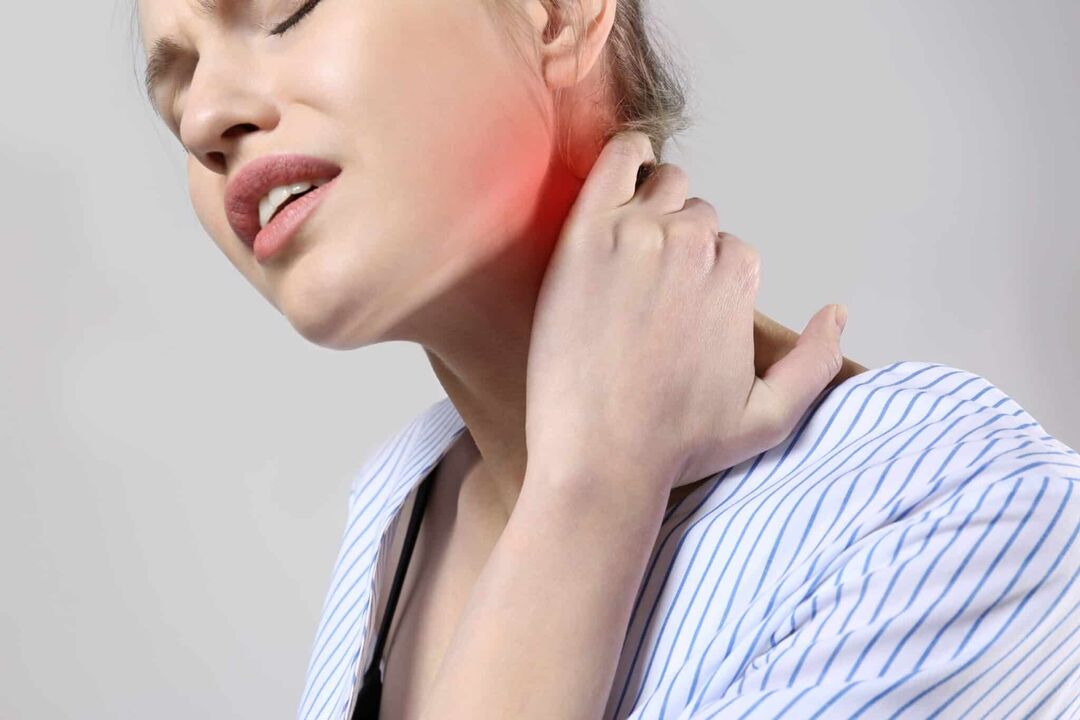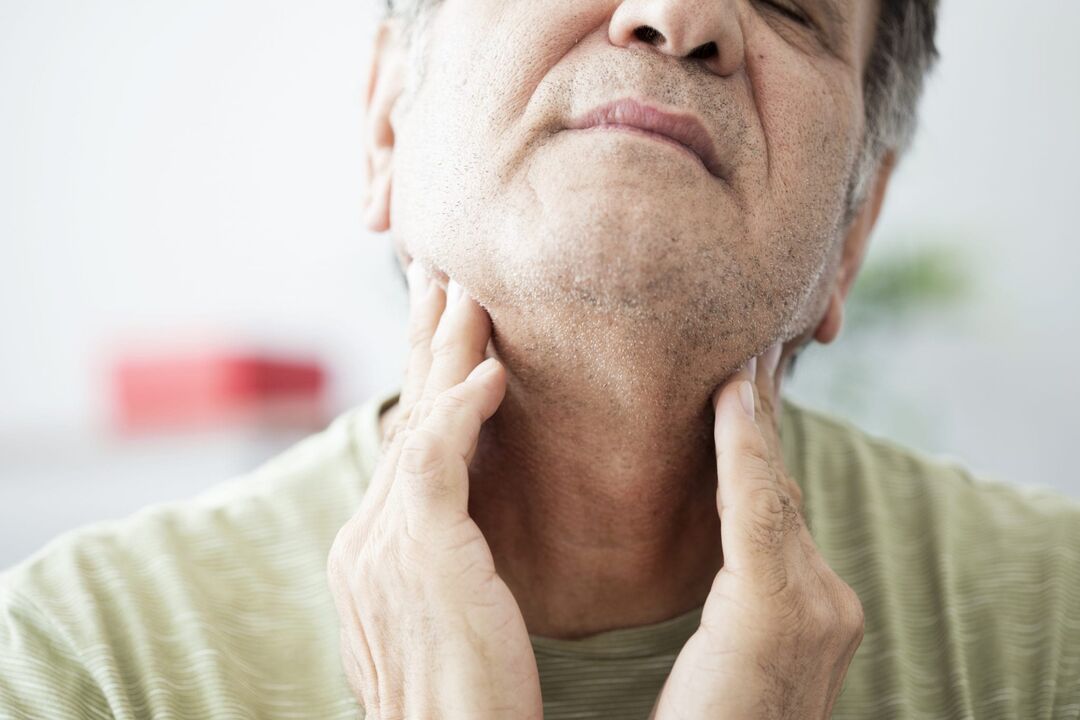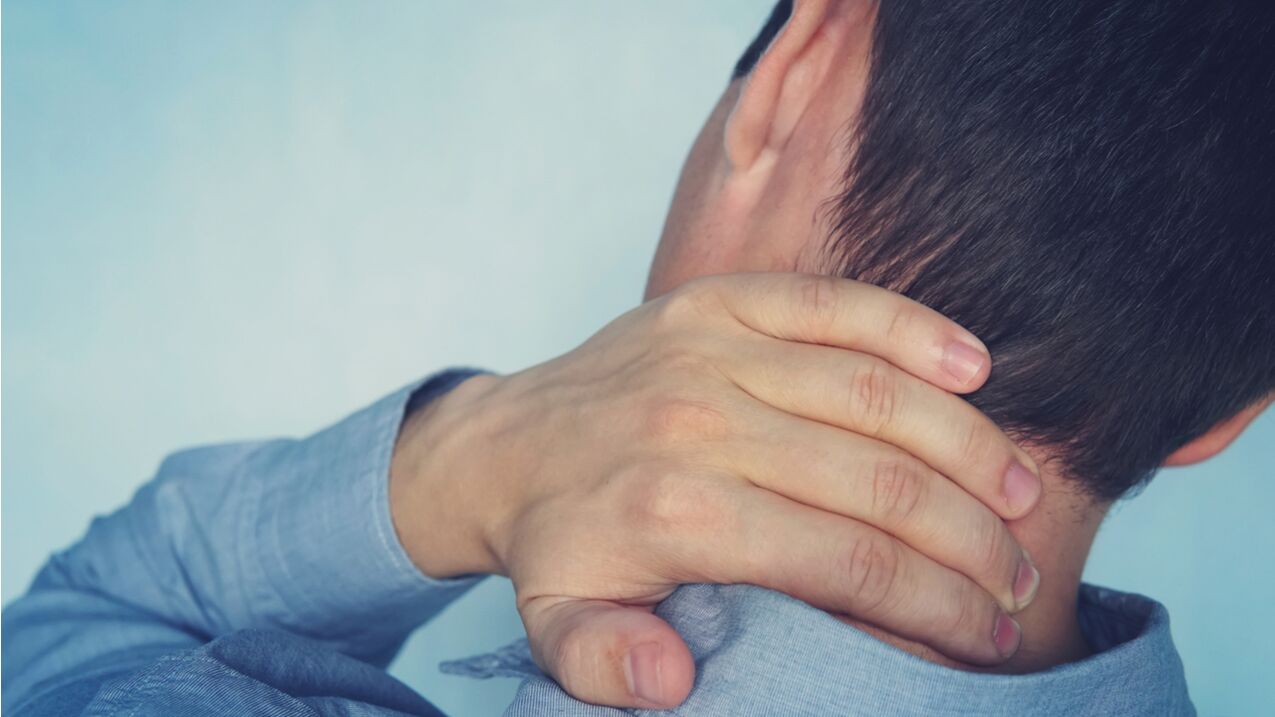
The neck is made up of vertebrae that run from the skull to the upper torso. Cervical discs absorb impacts between bones. Bones, ligaments and muscles support the head and allow it to move. If there is any abnormality, abnormality, inflammation or trauma, it can cause pain or stiffness in the neck area. At such times, it is difficult to immediately determine what the neck hurts and take any action.
Many people sometimes experience discomfort or stiffness in this area, most often due to poor posture or overexertion. In most cases, neck pain is not a serious condition and can be resolved within a few days. However, in some cases, this symptom can indicate a serious illness and requires a medical consultation.
This article will help you find out why your neck hurts on the right side as well as elsewhere. It will also provide a classification of the types of pain and its most common causes. Think about how you can get rid of discomfort in that part of your spine.

Types of pain in the cervical region
To prescribe effective treatment, a specialist must accurately determine the symptoms and causes of the condition. Doctors classify neck pain as follows:
- cervikago - lumbago;
- neck pain.
The last type involves pain from injuries to the vertebrae or cervical muscles. Neck pain, in turn, can be divided into pain:
- associated with skin lesions (superficial somatic);
- associated with muscle or vertebral damage (deep somatic);
- associated with the appearance in the body of an infection or disturbance in the functioning of Organs internal (visceral) organs.
Neck pain, which affects adjacent areas, is divided into:
- for cervicobrachialgia (pain goes from neck to shoulders);
- to cervicocranialgia (pain runs from the neck (through the back of the head) to the head).
Speaking of cervicago, it is noteworthy that this pain is always acute, it limits the mobility of the neck. It appears abruptly and torments the person for a while, so that it is impossible for him to think of anything else.
To determine why the neck hurts, it is extremely important that the doctor establish its nature and describe it using the classification listed.

common causes
Based on medical statistics, most often people seeking medical help for neck pain are diagnosed with a number of the following diseases and conditions:
- cervical osteochondrosis;
- osteoporosis;
- muscle spasm;
- herniated disc;
- lymph node inflammation;
- systemic diseases of the body (infectious processes, tumors, problems with the immune system).
However, pain can be caused not just by the presence of a person's illness. Discomfort may also be caused by muscle tension or stretching (from sitting for a long time at the computer, driving a car, lifting weights, uncomfortable sleeping posture or playing sports). In addition, discomfort may arise because the person has a headache closer to the neck.
Why is this happening and what is the root cause? Only an expert can answer this question. Sometimes people, trying to get rid of the discomfort, start self-medication - massage, antibiotics, pain relievers and other medications. However, the consequences of such actions may not be the most favorable.
You must understand what the diseases and conditions listed above are and how dangerous they can be, as well as why you cannot treat them yourself.

Cervical osteochondrosis
The appearance of this pathology in humans is associated with anatomical specificities. The dimensions of the cervical vertebrae are much smaller than the bony structures of other segments of the spine. The neck is constantly under stress, and this is due to the fact that its main functions are to support the head and ensure its mobility. If a person asks why the neck hurts behind, they need to see if they have osteochondrosis in that part of the spine.
The symptoms of this disease may be as follows:
- Pain from neck to shoulder, extending to the outer surface of the shoulder, forearm, and hands.
- Penetrating pain in the neck or occipital region (especially worse in the morning, with movement of the head, coughing, etc. ).
- Headache (paroxysmal or persistent, dull, impulsive, aggravated by turning the head), dizziness, blurred vision, ringing in the ears.
- Pain in the chest muscle.
- There is a violation of blood flow in the cerebral arteries, which sometimes leads to temporary loss of consciousness. As health deteriorates, speech and motor functions can be impaired.
There is no point in treating this illness alone, as the consequences of such actions can be far from happy. But by turning to professionals, one can be confident that the therapy will be of high quality and effective.
Typically, treatment for cervical osteochondrosis may include the use of various anti-inflammatories and pain relievers, restorative gels and ointments, physical therapy, and exercise for health. Various medicinal patches and so on can be used.
osteoporosis
This is a bone disease that occurs when bones lose their density. As a result, they become weak and can break when dropped or impacted. It is more common among women during menopause, but habits such as smoking, heavy drinking, poor diet and sedentary behavior increase the risk of its occurrence.

For many people, formulating such a diagnosis may be the answer to the question of why the neck hurts behind it and at the same time extends to the arms and shoulders.
Doctors distinguish three stages of this disease. The first stage assumes that a person begins to experience changes in the cervical spine as a decrease in density of the vertebrae, mild cramps, weakness and pain occur. In the second stage, constant headaches appear, blood pressure can drop dramatically and rise above normal, numbness in the hands and general weakness appear. The third (hardest) stage assumes that a person experiences severe deformities in the vertebrae, a bulge may appear in the collar area, and headaches and neck pain become constant companions.
The treatment of osteoporosis aims to delay or prevent its development, maintain bone mineral density and reduce pain. This is achieved through the use of supplements and medications, as well as a review of the person's lifestyle in favor of light but constant loads (walking, sports), proper nutrition.
muscle spasm
Why does the neck on the left side hurt? The cause could be a spasm. It not only occurs on the left, but can affect the right and the back of the neck. This is due to the involuntary contraction of the muscles as a result of intense effort. The situation usually causes severe pain that lasts from minutes to several days.
Asking why the muscles in the neck hurt, the person must think about how he sleeps, works, sits. Spasms often occur due to a violation of the body's natural position, the transfer of weight onto the shoulders, including bags, hunched shoulders, and other conditions (including serious illnesses).
Pain relievers can then help relieve neck pain, relieve muscle tension, and reduce inflammation. However, they should be taken following the attached instructions and with the doctor's knowledge. If you are unsure whether your neck pain is caused by a spasm, you should not take any medications before consulting a specialist. In this case, you can apply an ice pack (wrapped in a towel) to your neck to temporarily relieve the pain.
It's always good to remember that it's very difficult to independently determine what hurts in your neck. If the discomfort persists or intensifies, this can be a very serious reason to see your doctor.
Disc herniation
This element is a strong ligament that connects one vertebral bone to another. Discs are cushioning pads between each spinal vertebrae. A hernia in the cervical spine can occur when too much pressure is exerted, even on a healthy disc (carrying heavy loads, falling from a height).
Symptoms of this condition often include severe pain that may spread to one or both arms or legs, as well as numbness or tingling in the extremities, muscle weakness, and loss of sensation. Initially, a person may not understand why the neck hurts when turning, bending, or other usual movements. However, over time, the discomfort becomes unbearable. Some people may not have neck or back pain with a herniated disc. Where symptoms will manifest depends on where exactly the pathology is located.
The treatment of a herniated disc depends on the severity of the disease and the visible damage. Most of the time, people's condition improves within six weeks after the first visit to the doctor. In many cases, quality medication and physical therapy are sufficient. In therapy, drugs can be used to control pain, reduce muscle spasm.
Inflammation of lymph nodes
These pathologies usually result from exposure to bacteria or viruses. When these changes occur in the body, it is not difficult to understand why the neck hurts on the left or on the right, since these are the areas where the lymph nodes are located. They can swell in response to an upper respiratory infection such as a cold. Associated symptoms that may be present along with edema are coughing, fatigue, chills, runny nose, profuse sweating.

What Hurts Neck With Inflammation Of Lymph Nodes? The answer is simple: the pathological process affects the nerve endings, which send pain signals.
Treatment for this condition usually includes identifying its nature (virus, infection, bacteria, tumor). The doctor then prescribes medication to treat the root cause, which has a beneficial effect in removing the inflammatory process.
Various systemic disorders in the body
Sometimes people may not understand why their neck and head hurt, and these sensations go to their back or arms. This condition can often be caused by some systemic disorders of the body. These include various tumors, depression, arthritis, infectious processes, meningitis, internal bleeding and other serious pathologies.
Pain in the cervical region can also occur when the body does not receive the necessary amount of some useful substances (vitamins, micro and macro elements).
Why neck pain in front, back, or muscle discomfort and headaches are felt, only the doctor will answer according to the results of tests and additional studies. The root cause could be due to the poor condition of other organs, not just the collar area.

Diagnosis
The first thing that needs to be done to establish the cause causing neck pain is to consult a therapist. He will appoint the necessary consultation with other specialists and determine the need for technological diagnostic methods.
The specialist will explain why the neck hurts on the right, left or elsewhere. He will collect a complete history and determine what disorders in the body are currently taking place.
During the exam, a person may be given the following diagnostic methods:
- Magnetic resonance;
- CT;
- ECG;
- Ultrasound.
MRI can help determine the condition of tissues, CT scan - to identify pathologies in the cervical vertebrae, ultrasound is needed to study the arterial ring, vessels and nearby tissues, and ECG so the doctor can rule out various cardiac pathologies.
In addition, one of the mandatory tests is the study of the patient's blood, which will help determine if inflammatory or infectious processes are taking place in the body.
What to do?
Every person in pain wants to get rid of it as quickly as possible. For neck discomfort, the following may help:
- Apply ice to the painful area (initially wrap with a towel).
- If mild pain is caused by overexertion, you should temporarily stop heavy exercise and give your neck muscles time to rest.
- It is necessary to do light neck exercises (slow bends and bends) throughout the day.
- You must control your posture so as not to aggravate the situation with additional loads on your muscles and vertebrae.

If the pain persists within one to two days, you should seek help from a doctor who will determine why your neck hurts. If symptoms such as swollen lymph nodes, fever, numbness or tingling, swelling, nausea, and inability to move your head or limbs are added to this, you should immediately call an ambulance team or seek a specialist on your own.
Prophylaxis
In order not to wonder why the neck hurts closer to the head, elsewhere, or muscle spasms occur, it is important to monitor your health and follow some of the following recommendations:
- You only need to sleep on comfortable pillows that allow your cervical spine to relax during rest. To avoid neck and back problems, it is best to buy an orthopedic pillow.
- The best position for comfortable rest of the entire spine is lying on your back. You must train to fall asleep in this position.
- you need to choose the correct chair height and monitor position when working on your computer.
- It's not worth it to text, play games or read on mobile devices for a long time. This creates an excessive load on the neck (in most cases, during this activity, the head is lowered, which causes disturbances in the work of this part of the spine).
- It is important to be aware and find time for exercise, walking outdoors, and sports.
- You must adjust your diet and diet. It is very important that the body receives the necessary amount of nutrients throughout the day.
- It is better to abandon bad habits (eating too much, smoking, drinking alcohol and drugs).
Conclusion
Having considered the main reasons why the neck hurts, we can conclude that it is unlikely that it will be possible to establish and resolve the problem on your own. So it's important not to hesitate. You need to see a specialist right away, even if your neck pain can be tolerated. Remember that even a little discomfort can indicate disturbances in the body's functioning.












































